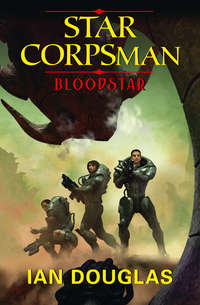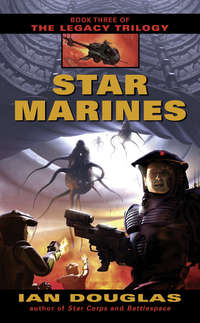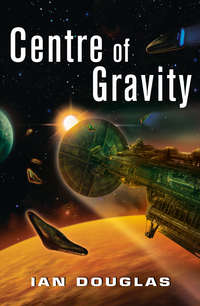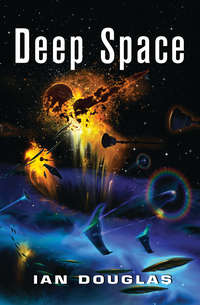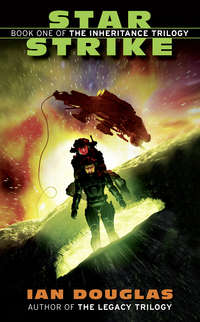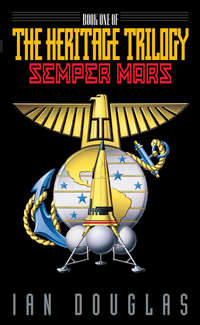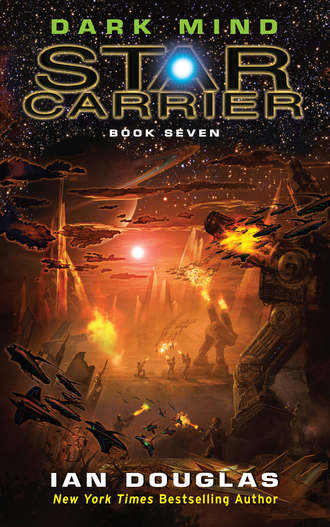
Полная версия
Dark Mind
Gene? Koenig called, sending a mind-to-mind call. Get your ass over here.
On my way, Mr. President.
Admiral Gene Armitage separated himself from a small mob on the other side of the huge room and made his way toward Koenig and the Pan-European general. Head of Koenig’s Joint Chiefs of Staff, Armitage was his principle military advisor and the man who would get the ball rolling in the planning of any new military operation.
“Herr Generalleutnant Kurz … head of the Joint Chiefs of Staff, Admiral Armitage.”
“We’ve met. Admiral? Good to see you again.”
“At Geneva last month,” Armitage said, nodding. “A pleasure, sir.”
“We’re going to be sending a contingent with the Confederation to Kapteyn’s Star, Gene,” Koenig said. “Discuss the details with the general, please, and then make it happen.”
“Aye, aye, sir.” Armitage’s expression remained shuttered, giving nothing away. Which was commendable, seeing as he’d been the one who’d recommended that Koenig not give the Pan-Europeans an immediate answer.
The biggest problem, Koenig thought, turning away and leaving the two to talk in private, was the fact that few in the USNA military trusted the Confederation yet. The Brits were okay; their defection during the war had accelerated the enemy’s disintegration as a coherent fighting force. The Russians, the North Indians … the USNA could work with them well enough. But the Pan-European destruction of the city of Columbus the previous year had left the USNA with a bitter taste in its mouth, and the fact that the attack apparently had been carried out by renegade elements within the Genevan government hadn’t made the bitterness easier to swallow. There were still many within the former United States who wanted to charge the Pan-Europeans, in particular, with crimes against Humankind.
That, Koenig reflected, isn’t going to happen. Behind-the-scenes deals cut by his administration before the public negotiations had guaranteed the Confederation immunity from war-crimes charges if they would agree to the peace talks. That strategy had been strongly urged by Konstantin, the powerful AI located on the far side of Earth’s moon. The USNA was clearly winning the short, sharp war against the Confederation, but they needed peace. They were in very nearly as bad a shape as the Pan-Europeans—worse, possibly, after major strikes against American soil—and with the looming advance of the Rosette Aliens, Humankind needed to come together in a united front now, at any cost.
Koenig didn’t always understand Konstantin’s logic, but this time it seemed straightforward enough. It still wasn’t clear that the Rosette Aliens were overtly hostile, but they had destroyed human ships and bases, and Humanity had to come before any petty geopolitical squabbles.
Especially since, in the background, the alien Sh’daar, time-travelers from the remote past determined to block Humankind from its approaching technological singularity, always lurked in ambiguous mystery. They’d agreed to a cease-fire with Earth … but for how long? Their long-term motives were still far from clear.
Shadowed by his four bodyguards, Koenig made his way to one of several bars set up on the slowly turning floor. They moved with a fluidity that betrayed an essential fact: presidential security was now handled by robots—in this case a quartet of human-looking androgynoids far faster, stronger, and smarter than anything modeled in flesh and blood. They could pass as human—very nearly—though the deliberate blurring of sexual characteristics gave them a touch of the uncanny valley effect. Like the old United States Secret Service, you could tell what they were by the fact that they constantly watched everyone in the room except for the person they were protecting.
Koenig ordered a jovian from the robotic bartender. One of the security bots closely scanned both the botender and the mirror-polished globe it passed to Koenig.
“Thank you,” he told the robot behind the bar. He glanced at the security machine and cocked an eyebrow. “Don’t worry. He’s one of yours.”
“Of course, Mr. President.” But it completed the scan anyway. Security was a lot tighter—and far more automated—since the Confederation strike at Columbus.
He wasn’t actually complaining.
“Mr. President,” a woman said behind him. “I haven’t had a chance to welcome you to D.C.”
Koenig turned to face Shay Ashton—Governor Shay Ashton, rather. Once a crack USNA fighter pilot, she’d retired to her home in the D.C. swamps, and ended up leading the defense of the ruins when the Confederation tried to claim some of the supposedly abandoned USNA Peripheries for themselves. She’d gone on to become interim governor for D.C. as it was formally reintegrated into the country, and was titular head of the territory now. There were rumors that she was going to be drafted as one of the D.C. representatives to Congress in next year’s general elections, though she’d not formally announced her candidacy.
He smiled. “Madam Governor! It’s good to see you again.”
Two of the security ’bots were giving her a very close scan, checking for weapons, explosives imbedded inside her body, anything at all that might be a threat. It was hard to see how she could be hiding much; she was wearing a holographic sheath of rippling light in greens and blues, with the image of the Freedom’s Star ribbon glowing above her left breast. An animated tattoo of a bright green butterfly opened and closed its wings on her right cheek.
She smiled sweetly at one of the machines. “See anything you like?”
“That will do,” Koenig told the machines. “I’ve known Ms. Ashton for a long time, and if she’s a threat, it’s definitely to the other guys.”
“Of course, Mr. President,” one said … but, as with the ’botender, they completed their scans.
“Machines,” she said. “I still can’t get used to them.”
“I know what you mean.” Actually, Koenig thought, he didn’t know what she meant … he couldn’t. Shay had been born and raised outside of the USNA’s comfortable high-tech envelope, where the locals had to farm and fish just to survive. She’d been exposed to advanced technologies, certainly—from robots to genetic prostheses to AIs to nano-grown cerebral implants during her tour in the Navy—but you really needed to have grown up with that sort of technology to get the most out of it. Even now, millions of people all over the country were Prims—Primitives—people brought up in the Peripheries, who didn’t have access to high tech, or who’d come to it later in life.
The expression on her face told him she’d caught him out, and he shrugged. “Sorry.”
“That’s okay, Mr. President.” Her right forefinger touched her forehead, her left the center of her sternum. “You’re almost there … thirty centimeters.”
He chuckled and nodded. Thirty centimeters—the distance between brain and heart. Knowing a fact was different from feeling it.
Koenig lightly squeezed the silver jovian in his hand, and the upper surface slid open, releasing a small, thick puff of greenish vapor. He inhaled, savoring the tingling rush channeling directly to his brain.
He smiled at Ashton. “Can I get you one of these? They’re good …”
“Thank you, no, sir. Prims have trouble with brainstimming, sometimes. I can’t handle the stuff.”
The green vapor consisted of clouds of nanotechnic units programmed to send waves of pleasurable sensations directly into the brain via the olfactory bulb. The sense of smell was the only one hardwired directly into the brain rather than through a long chain of nerves, and brainstimming gave a socially acceptable euphoric buzz without impairment or hangover. People who’d received their cerebral implants later in life, however, rather than as small children, could have trouble handling the storm of sensations, could become disoriented and might even pass out. Such, apparently, was the case with Ashton.
“Of course.”
“So we’re really going to go through with this, Mr. President? The new alliance, I mean?”
“It seems to be the best course for us. For Earth, I mean.”
“That’s assuming we can trust them.” She nodded toward General Kurz, now deep in conversation with Armitage.
“Well … yes.”
“Some of them wanted to sell out to the Sh’daar.”
“I know, Ms. Ashton. And to a certain extent I agree with you. But Konstantin says that we won’t survive another encounter with the Sh’daar if we don’t work with the Confederation … to say nothing of the Rosette Aliens. We unite, or we die. There is no middle ground.”
“Konstantin.” She made a face. “Another machine.”
“A machine some thousands of times smarter—and millions of times faster—than any organic brain we’ve encountered.”
“That’s right. Smarter … so smart we don’t know what it’s really thinking. Or what it’s planning for the future.”
He smiled. “Perhaps you’d like to sit in on the next meeting of my cabinet.”
She looked shocked. “Oh! I’m sorry! I didn’t mean to suggest—”
He waved her down with a gentle motion of his hand. “No, no. That’s okay. I was just picturing you tearing into Sarah Taylor, the secretary of Alien Affairs. Or Phil Caldwell. It might be fun.”
A USNA admiral in full dress approached them. “Do you need rescuing, Mr. President?”
“Not at all, Vince. The governor was just … questioning certain affairs of state.”
Admiral Vincent Lodge smiled at Ashton. “Maybe you need rescuing from him.”
“I think I can watch out for myself, Admiral.”
“Good.” He looked at Koenig, and some of the humor drained from his eyes. “Mr. President? A word, if I could?”
“Excuse us, Ms. Ashton?”
“Of course.”
They stepped aside. “What’s the word?”
“Mr. President … we’ve received a Konstantin intercept.”
Konstantin had intelligence connections imbedded all over Earth, and well beyond. Admiral Lodge was the head of Naval Intelligence … the human head, rather, since in many ways Konstantin was the true director of cyberintelligence. A Konstantin intercept meant that the AI had picked up a transmission of some sort, probably classified and definitely important, if Lodge was interrupting him at a party about it.
“Tell me.”
“A courier just dropped into normal space outside Neptune’s orbit and began transmitting. It’s from Kapteyn’s Star … from the Pan-European monitor they sent out there.”
“Go on …” Couriers were high-speed interstellar vessels, usually unmanned, that could make the Alcubierre passage between the stars much more quickly than larger, more cumbersome star-faring vessels. They wouldn’t have sent one if things weren’t critical.
“We know what the Rosettes are doing at Heimdall, sir. They’re waking up the Kapteyns. They may be assimilating them.”
“The Kapteyns!”
“Yes, sir. And for the first time, we just may have gotten a glimpse of what the Rosette Aliens are after.”
“You have my full attention,” Koenig told him.
Chapter Two
29 October 2425
TC/USNA CVS America
Admiral’s Quarters
0425 hours, TFT
Admiral Trevor “Sandy” Gray came awake in a darkened and empty room. Still half asleep, he clawed at the loneliness of the bed next to him. Where was she? It took him several moments to figure out where he was … his quarters on board the star carrier America.
Damn … it had seemed so real.
But then, it always did.
His partner in the erotincounter had been named Marie; for once she had not been Angela, his one-time wife, nor had it been his most recent partner, Laurie Taggart, who’d recently been transferred to the Lexington. Marie was pure fiction, created by one of America’s AIs, and very loosely based on a current sex-drama actress who went by the same name. In-head dramas, fed into people’s internal hardware, were a major source of both entertainment and education. Gray preferred interacting with electronic avatars to address his sexual desires, rather than sexbots. The sensations and results were the same … but the relationship played out inside his brain rather than in his bed. So when the illusion dissolved, so did the partner. The feeling was precisely that of waking from a dream, and that could leave you feeling empty and a bit lonely.
“Admiral Gray,” a voice whispered in his head. “Admiral Gray. Sorry to wake you, sir, but we’re coming up on the triggah.”
“Very well,” he replied. The voice was that of Eric Conrad, his new chief of staff. He sat up, stretched, and thoughtclicked the room’s lights to higher brightness.
Unlike a dream, the memory of his encounter with Marie hadn’t evaporated upon waking. The memories were written directly to his long-term memory; the human brain literally could not tell the difference between what happened within its network of neurons and what happened in the real world outside.
Somehow, that made the loneliness worse.
But it kept his sex life uncomplicated.
“How close are we?” he asked over the open circuit. He took a small capsule from a dispenser and slapped it against his naked chest. The nanomaterial turned semi-liquid with the shock and flowed swiftly over his body from neck to feet, solidifying in seconds into closely woven shipboard utilities, complete with rank tabs at the throat.
“Twelve thousand kilometers, sir,” Conrad replied. “We have battlespace drones out, and they’re sending back some good images.”
“Let me see.”
The bulkheads of Gray’s quarters went dark, then lit once more, showing a projection of surrounding deep space. Stars hung suspended in velvet blackness. Directly ahead, robot drones sent back images of the TRGA—the Texaghu Resch Gravitational Anomaly. From this aspect, it appeared to be a perfect circle, gray-rimmed, surrounded by a faint haze of dust and debris.
Properly known either as the Sh’daar Node or as the TRGA, the circle was in fact a hollow cylinder of ultra-dense matter twelve kilometers long and one wide, rotating about its long axis at close to the speed of light. Located over 200 light years from Sol, the TRGA—a “triggah” in Navy slang—was clearly artificial and clearly the product of an unimaginably advanced technology. There were others besides this one—tens of thousands, perhaps, scattered across the galaxy as a kind of spacetime transportation net. At one time, Earth Military Intelligence had believed that the alien Sh’daar had created the things; certainly they used them, as did human star-farers. But no one knew for sure who’d actually built them in the first place, not even the information traders known to Humankind as the Agletsch. They worked, and for most people, that was enough.
This particular TRGA was the first one discovered by human explorers, thanks to information provided by Agletsch traders. Just recently, it had been given the code name Tipler, after twentieth-century physicist Frank Tipler, who had worked out the math for Tipler cylinders—titanic, ultra-massive constructs that might allow travel across vast areas of space and even through time. The TRGAs had turned out to be related to Tipler cylinders, but inside out—rotating hollow tubes rather than solid cylinders—though the effect was the same.
Perhaps a dozen TRGAs were now known, all of them named for important physicists and cosmologists from the past few centuries.
Sometimes Gray wondered if they’d have been surprised to see their theories become reality.
The circle slowly grew larger in size as America and her supporting fleet approached it. That cylinder, Gray knew, held the mass of a sun the size of Sol somehow compressed into something akin to neutron-star material. Inside that fast-rotating shell, Jupiter-sized masses rotated and counter-rotated, stretching local spacetime beyond the breaking point. That haze was in part dust, and in part gravitational distortions in the space within which the triggah was imbedded.
And they were about to go through it.
“Fighter status?” Gray asked.
“VFA-96 is ready for launch, Admiral,” the staff officer replied. “Awaiting your word.”
“Launch fighters,” Gray replied. “And go to battle stations.”
He was already on his way up to America’s bridge as the battle-station alarms sounded.
Lieutenant Donald Gregory
VFA-96, Black Demons
0440 hours, TFT
“It’s too fucking early …” Don Gregory complained.
“There ain’t no day or night in space, youngster,” squadron commander Luther Mackey replied. “So no early or late. Deal with it.”
“It’s zero-dark thirty, Skipper,” Gregory replied, “and I haven’t had my damned coffee yet.”
“My … grouchy first thing, aren’t we?” Lieutenant Gerald Ruxton said over the tactical channel, laughing. He sounded … awake, Gregory thought. Disgustingly so. Bright, cheerful, and—considering the fact that he’d been in the ship’s bar drinking with him about five hours ago and was, therefore, just as short on sleep as he—
“Ice it down, people,” Mackey said. “Bearing one-seven-five by minus three-one. We’re clear for launch. America has cut thrust and is drifting. Fifteen hundred kps …”
Gregory’s SG-420 Starblade fighter absorbed the incoming data even as the skipper relayed it in staccato fashion. He could feel the flick and trickle of numbers downloading through his skull.
“Launch in three …” Mackey said, “… and two … and one … release!”
Mounted in the outer deck of the second rotating hab module, the fighters of Black Demon squadron, VFA-96, began sliding down their launch tubes, impelled by a half G’s worth of centrifugal force. Gregory was third in the queue; together with Lieutenant Bruce Caswell’s Starblade, he dropped into blackness, slowly drifting clear of the shadow of America’s massive forward shield cap, then rotated to align his craft parallel to the far larger star carrier. The ship was an immense mushroom shape nearly a kilometer long, its shield cap a hemispherical water reservoir four hundred meters across. Ahead, partially obscured by the shield cap, the perfect circle of the TRGA—blurred by rotation and by a fiercely twisted spacetime—hung suspended in the distance.
The remaining VFA-96 fighters dropped from the habmodule flight decks and took up station with the others, a flight of twelve Starblades already morphing into highvelocity teardrop shapes. Even in the vacuum of space, streamline counted for ships moving at close to c.
“America CIC, this is Point One,” Commander Mackey said. “Handing off from PriFly. All Demons clear of the ship and formed up.”
“Copy, Point One,” a voice replied from America’s Combat Information Center. “Primary Flight Control confirms handoff to CIC. You are clear for maneuver. You may proceed.”
“Okay, boys and girls,” Commander Mackey said, addressing the squadron. “Time to thread the needle. Initiate program.”
Tightly knotted gravitational singularities winked on just ahead of each fighter, dragging it forward as it flickered in and out of existence at thousands of times per second, accelerations building rapidly as America slid past the fighters, then began dwindling astern.
VFA-96 had drawn the short straw on this mission … flying point, leading America and her battle group into and through the huge, fast-spinning cylinder ahead. Gregory wasn’t entirely sure he was ready for this. Three months ago—or 12 million years in the future, depending on how one counted things—his fighter had been damaged, and he’d briefly been marooned on the surface of Invictus, a frigid rogue planet wandering the darkness beyond the galaxy’s rim. He’d lost his legs … and he’d lost Meg Connor, a woman he’d loved very much. The legs had grown back and he’d learned how to walk again.
But other wounds were a hell of a lot harder to heal.
He had to force his mind away from thoughts of Meg. The Black Demons had lost a lot of pilots at Invictus, and very, very nearly lost him as well.
Maybe, he thought, it would have been better if he had died.
TC/USNA CVS America
Flag Bridge
0451 hours, TFT
“Admiral on the bridge!”
“As you were.” The call and the response were largely for tradition’s sake, since coming to attention in zero-gravity was more or less pointless. In any case, it would have been bad form to interrupt personnel working their consoles and links.
Gray entered the flag bridge, giving a gentle tug to pull himself along one of the tethers that roped different parts of the double bridge complex together. Parts of America, those within the rotating hab module section—mostly personnel quarters and the fighter launch and recovery decks—were under spin gravity, but the flag bridge and the adjacent ship’s bridge were located in a tower rising from the star carrier’s spine forward of the hab sections, and therefore in zerogravity.
He positioned himself in the command chair and let it tighten around his hips. He placed the palms of his hands on the seat’s contact plates, letting them connect with his neural interfaces. Datastreams began flowing through his brain, opening in-head windows and connecting him with the AIs running both the ship and the fleet.
There was no up or down in zero-gravity, of course, but from the vantage point of his command chair, he was looking down onto the ship’s bridge forward. The flag bridge formed a kind of gallery overlooking the ship’s command center, where he could see about a dozen officers and enlisted personnel working at their consoles under the watchful electronic gaze of Captain Sara Gutierrez. On the large curving bulkhead above the bridge entrance glowed a projection of surrounding space, with the blurred and perfectly circular ring of the TRGA centered dead ahead. Dwindling numbers to the side gave range and closing velocity.
“The Demons are going in,” the voice of Captain Connie Fletcher reported, whispering in his mind. She was America’s CAG, the officer commanding the various fighter and auxiliary squadrons.
“Tell them—” Gray stopped. He’d been about to wish them “Godspeed,” but that would have been less than appropriate. There were those who thought the TRGAs had indeed been constructed, eons in the past, by godlike aliens, and the White Covenant discouraged statements that might be interpreted as religious sentiment by others. “Tell them good luck,” he said. It might be a bit lame, but it shouldn’t offend anyone.
“Aye, aye, Admiral.”
Icons marking the twelve fighters of the Black Demon squadron appeared ahead, superimposed against the TRGA’s maw. And then …
They were gone.
Let me see the fleet disposition, Gray thought. The viewpoint pulled back from America, so that the star carrier could be seen from the side, in the distance. Other icons appeared strung out behind her. America was followed in line-ahead by the railgun cruiser Leland … and behind her came the alien Nameless. The Glothr, it seemed, didn’t name their ships, so the humans on the expedition had given the vessel a name of their own.
Not quite the most clever name, but there you go.
The fighters were through. Data began pulsing back … but broken and static-blasted. Communication across a TRGA gateway tended to be intermittent and unsatisfactory, requiring precisely positioned transmitters and receivers, as well as a great deal of power. There was enough to tell the battle group that the fighters had emerged, however, and apparently in the right epoch.
Fighter pilots called it threading a needle … a reasonable analogy. The interior opening of a TRGA was only slightly wider than America was long. Still, within the TRGA’s lumen, minute variations in position and velocity created wildly different pathways through space and time. The ships of the America battlegroup were following a carefully programmed and precise series of maneuvers as they entered the spinning maw.





